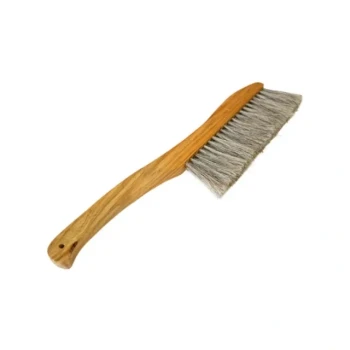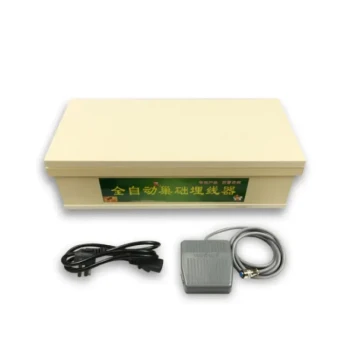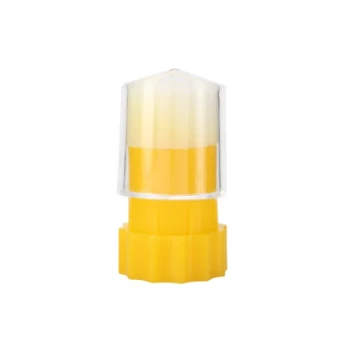Choosing the right beekeeping boots is about more than just avoiding stings; it's about creating a secure, comfortable, and stable foundation for your work. The best boots are high enough to cover your ankles, made from a smooth, impermeable material like rubber, and fit snugly to prevent bees from crawling under your pant legs.
Your footwear isn't just a piece of equipment; it's the critical seal at the bottom of your protective suit. The primary goal is to choose a boot that integrates seamlessly with your bee suit or pants, creating an unbroken, sting-proof barrier from the ground up.
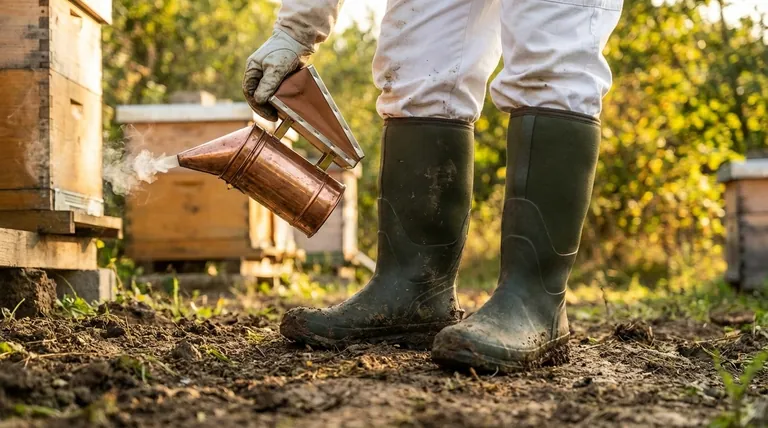
The Core Principles of Beekeeping Footwear
To make an informed choice, you must understand the functional requirements of working in an apiary. The visual style of the boot is far less important than these four principles.
Principle 1: Creating an Impenetrable Seal
The most vulnerable point for bees to enter your suit is the gap between your pants and your footwear. Your boots must be high enough to extend well past the ankle.
This height allows you to securely tuck your pant legs into the boots or pull the elastic cuffs of your bee suit down over the top of the boots, creating an overlapping, bee-proof seal.
Principle 2: Material and Sting Resistance
A bee's stinger can penetrate fabric, but it cannot get through thick rubber or neoprene. These waterproof materials are the standard for beekeeping boots for a reason.
Their smooth surface also gives bees nothing to grip onto, making it less likely for them to land and attempt to sting in the first place. Avoid boots made of canvas or other woven materials.
Principle 3: Stability and Support
You will spend hours on your feet, often on uneven or soft ground. Your boots need to provide good traction to prevent slips, especially when you might be carrying a heavy super full of honey.
Good ankle support is also crucial for preventing twists and strains, allowing you to move around the apiary with confidence and focus on your bees, not your footing.
Principle 4: Practicality and Ease of Cleaning
Apiaries can be muddy, and you will inevitably get honey, wax, and propolis on your boots. A key feature of a good beekeeping boot is the ability to be hosed off easily.
Smooth, waterproof surfaces can be cleaned in seconds, preventing you from tracking messes into your car or home and keeping your gear in good working order.
Common Boot Types for the Apiary
While many boots can work, three types are most frequently used by beekeepers, each with its own profile.
The Workhorse: Rubber & Neoprene Boots
These are often sold as "agricultural boots," "farm boots," or under brand names like Muck Boots. They are the most practical and popular choice for beekeepers.
They perfectly embody all the core principles: they are high, waterproof, sting-proof, stable, and incredibly easy to clean. Their versatility makes them a great investment for other outdoor work as well.
The Specialist: White Beekeeper Boots
These are purpose-built boots, typically made of white rubber or PVC. Their main feature is their color, as bees are generally less agitated by lighter colors.
While perfectly functional, they offer little practical advantage over a standard agricultural boot and are not as versatile for other farm or garden tasks.
The Compromise: High-Top Work Boots
A sturdy, over-the-ankle leather work boot can be used if it's all you have available. However, they present a clear compromise.
Laces and seams can provide places for bees to grab or get trapped, potentially leading to stings. Furthermore, most are not waterproof and are much more difficult to clean than rubber boots.
Understanding the Trade-offs
Choosing the right boot means being realistic about your needs and what to prioritize.
Specialized vs. Multi-Purpose
A dedicated white beekeeper boot looks the part but often serves only one purpose. A high-quality agricultural boot provides identical protection in the apiary while also being useful for gardening, rainy days, or any other muddy job. For most people, the multi-purpose boot offers significantly better value.
The Importance of Fit Over Style
Do not prioritize special "bee" emblems or a specific color over function. A dark-colored, well-fitting rubber boot that creates a perfect seal with your pants is infinitely safer than a low-cut white sneaker. The seal is everything.
What to Absolutely Avoid
Under no circumstances should you wear sandals, Crocs, mesh sneakers, or any low-cut shoe in the apiary. These offer zero protection and directly expose your ankles and feet, creating an obvious and dangerous entry point for bees. Dropping a frame of bees near open-toed shoes is a recipe for a bad day.
Making the Right Choice for Your Apiary
Your decision should be guided by your specific situation and priorities.
- If your primary focus is maximum safety and value: Choose a high-quality, waterproof agricultural boot made of rubber or neoprene that extends mid-calf.
- If you are on a tight budget: Use the sturdiest, highest-top boots you already own and be extra diligent about securing your pant legs over them with straps or heavy-duty rubber bands.
- If you prefer dedicated equipment for every task: A specialized white beekeeper boot will serve you well, provided it meets the core principles of height and material.
Ultimately, the best boot is one that lets you work confidently and forget about your feet.
Summary Table:
| Principle | Key Consideration | Why It Matters |
|---|---|---|
| Seal | Boot height extends past the ankle | Prevents bees from crawling under pant legs |
| Material | Smooth, waterproof rubber or neoprene | Sting-proof and easy to clean |
| Stability | Good traction and ankle support | Prevents slips on uneven ground |
| Practicality | Easy to hose off after use | Maintains cleanliness and gear longevity |
Ready to gear up with the right protection?
At HONESTBEE, we supply commercial apiaries and beekeeping equipment distributors with durable, high-performance beekeeping boots and full protective gear. Our wholesale-focused operations ensure you get reliable equipment that prioritizes safety, comfort, and value—so you can focus on your bees, not your footing.
Contact HONESTBEE today to explore our range of beekeeping supplies tailored for professionals.
Visual Guide
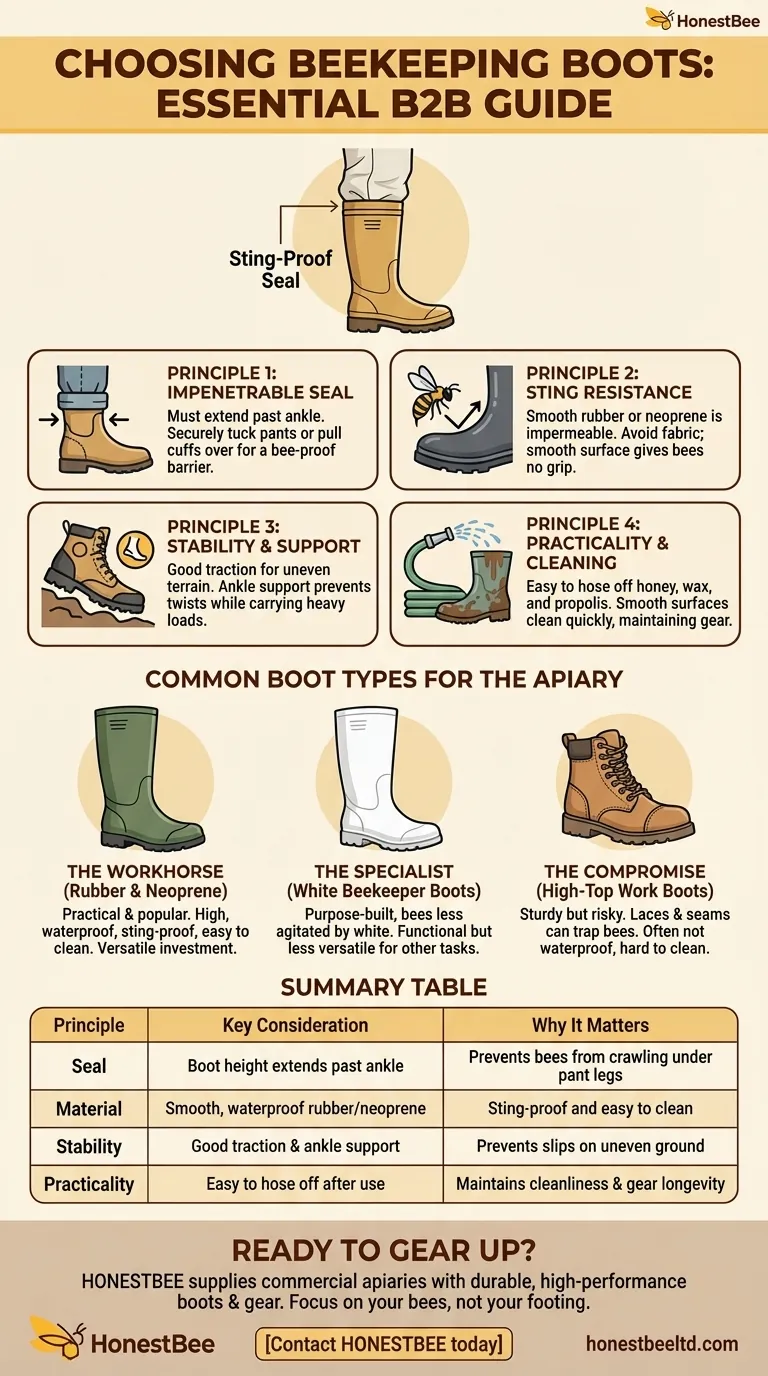
Related Products
- Premium Traditional Copper Bee Smoker with Bellows
- Beekeeper Cowboy Hat and Veil for Beekeeping
- Professional Engraved Round Hive Number Tags for Beekeeping
- Premium Triple-Row Horsehair Bee Brush
- Professional Adjustable Timer Electric Wire Embedder
People Also Ask
- What is the primary purpose of using smoke in beekeeping? Calm Bees for Safer Hive Management
- How does water mist work as an alternative to smoke in beehives? A Guide to Safe & Effective Use
- What happens to bees when they sense smoke? Unlock the Secret to Calm Hive Inspections
- What is a Smoker and how is it used in beekeeping? The Essential Tool for Calm, Safe Hive Inspections
- What are the main parts of a bee smoker? Essential Components for Calm Hive Management



